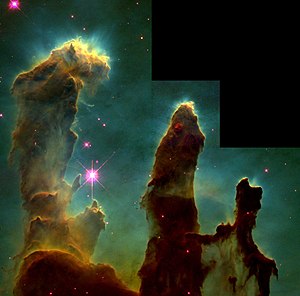
KNOWPIA
WELCOME TO KNOWPIA
Summary
Aesthetics of science is the study of beauty and matters of taste within the scientific endeavour. Aesthetic features like simplicity, elegance and symmetry are sources of wonder and awe for many scientists, thus motivating scientific pursuit.[3] Conversely, theories that have been empirically successful may be judged to lack aesthetic merit, which contributes to the desire to find a new theory that subsumes the old.[4]

The topic has been addressed by several publications discussing how aesthetic values are related to scientific experiments and theories.[5][6]
See also edit
References edit
- ^ Wyatt, Ryan (2015-01-05). "New Pillars of Creation". California Academy of Sciences. Retrieved 2022-04-15.
- ^ Drake, Nadia (2015-01-05). "Hubble Revisits an Icon, the Pillars of Creation". National Geographic. Archived from the original on June 5, 2021. Retrieved 2022-04-15.
- ^ Owens, Brian (2022-03-17). "Beauty and wonder of science boosts researchers' well-being". Nature. doi:10.1038/d41586-022-00762-8. PMID 35301500. S2CID 247520530.
- ^ Ivanova, Milena (October 2017). "Aesthetic values in science". Philosophy Compass. 12 (10): e12433. doi:10.1111/phc3.12433. ISSN 1747-9991.
- ^ Ivanova, Milena; French, Steven, eds. (2020). The Aesthetics of Science: Beauty, Imagination and Understanding. Routledge. ISBN 978-0-367-14114-1. OCLC 1143820195.
- ^ Ivanova, Milena (March 2021). "The aesthetics of scientific experiments". Philosophy Compass. 16 (3). doi:10.1111/phc3.12730. ISSN 1747-9991. S2CID 233824860.


